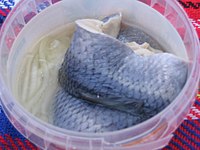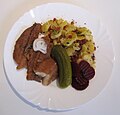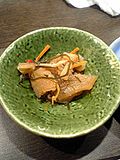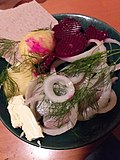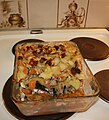
A kipper is a whole herring, a small, oily fish, that has been split in a butterfly fashion from tail to head along the dorsal ridge, gutted, salted or pickled, and cold-smoked over smouldering wood chips.

Herring are forage fish, mostly belonging to the family of Clupeidae.

Roe or hard roe is the fully ripe internal egg masses in the ovaries, or the released external egg masses, of fish and certain marine animals such as shrimp, scallop, sea urchins and squid. As a seafood, roe is used both as a cooked ingredient in many dishes, and as a raw ingredient for delicacies such as caviar.
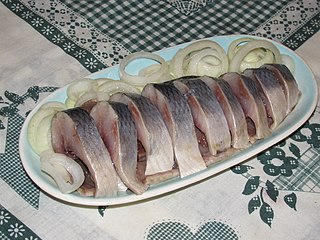
Pickled herring is a traditional way of preserving herring as food by pickling or curing.

Soused herring is raw herring soaked in a mild preserving liquid. It can be raw herring in a mild vinegar pickle or Dutch brined herring. As well as vinegar, the marinade might contain cider, wine or tea, sugar, herbs, spices, and chopped onion.

Smørrebrød, smørbrød "butter bread" (Norwegian), or smörgås "butter goose" (Swedish), is a traditional open-faced sandwich in the cuisines of Denmark, Norway and Sweden that usually consists of a piece of buttered rye bread, topped with commercial or homemade cold cuts, pieces of meat or fish, cheese or spreads, and garnishes.
Norwegian cuisine in its traditional form is based largely on the raw materials readily available in Norway and its mountains, wilderness, and coast. It differs in many respects from continental cuisine through the stronger focus on game and fish. Many of the traditional dishes are the result of using conserved materials, necessary because of the long winters.

Pickling is the process of preserving or extending the shelf life of food by either anaerobic fermentation in brine or immersion in vinegar. The pickling procedure typically affects the food's texture and flavor. The resulting food is called a pickle, or, if named, the name is prefaced with the word, 'pickled'. Foods that are pickled include vegetables, fruits, mushrooms, meats, fish, dairy and eggs.

Smoked fish is fish that has been cured by smoking. Foods have been smoked by humans throughout history. Originally this was done as a preservative. In more recent times fish is readily preserved by refrigeration and freezing and the smoking of fish is generally done for the unique taste and flavour imparted by the smoking process.

Fresh fish rapidly deteriorates unless some way can be found to preserve it. Drying is a method of food preservation that works by removing water from the food, which inhibits the growth of microorganisms. Open air drying using sun and wind has been practiced since ancient times to preserve food. Water is usually removed by evaporation but, in the case of freeze-drying, food is first frozen and then the water is removed by sublimation. Bacteria, yeasts and molds need the water in the food to grow, and drying effectively prevents them from surviving in the food.

A buckling is a form of hot-smoked herring similar to the kipper and the bloater. The head and guts are removed but the roe or milt remain. They may be eaten hot or cold.

Cured fish is fish which has been cured by subjecting it to fermentation, pickling, smoking, or some combination of these before it is eaten. These food preservation processes can include adding salt, nitrates, nitrite or sugar, can involve smoking and flavoring the fish, and may include cooking it. The earliest form of curing fish was dehydration. Other methods, such as smoking fish or salt-curing also go back for thousands of years. The term "cure" is derived from the Latin curare, meaning to take care of. It was first recorded in reference to fish in 1743.
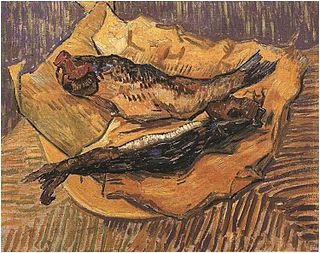
Bloaters are a type of whole cold-smoked herring. Bloaters are "salted and lightly smoked without gutting, giving a characteristic slightly gamey flavour" and are particularly associated with Great Yarmouth, England. Popular in the 19th and early 20th centuries, the food is now described as rare. Bloaters are sometimes called a Yarmouth bloater, although production of the product in Yarmouth appears to have now ceased in the town with the closure of its smoked fish factory in 2018. The bloater is also sometimes jokingly referred to as a Yarmouth capon, two-eyed steak, or Billingsgate pheasant.

Surströmming is lightly salted, fermented Baltic Sea herring traditional to Swedish cuisine since at least the 16th century. It is distinct from fried or pickled herring.

Sardines ("pilchards") are a nutrient-rich, small, oily fish widely consumed by humans and as forage fish by larger fish species, seabirds and marine mammals. Sardines are a source of omega-3 fatty acids. Sardines are often served in cans, but can also be eaten grilled, pickled, or smoked when fresh.

Anchovies are small, common saltwater forage fish in the family Engraulidae that are used as human food and fish bait. There are 144 species in 17 genera found in the Atlantic, Indian, and Pacific Oceans. Anchovies are usually classified as oily fish. They are small, green fish with blue reflections due to a silver longitudinal stripe that runs from the base of the caudal fin. They range from 2 centimetres (0.79 in) to 40 centimetres (16 in) in adult length, and the body shape is variable, with more slender fish in northern populations.

Cod and other cod-like fish have been widely used as food through history. Other cod-like fish come from the same family (Gadidae) that cod belong to, such as haddock, pollock, and whiting.


